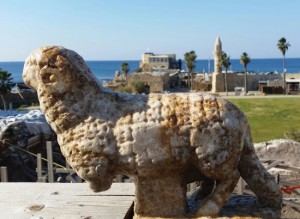×


We have detected your country as:
Please click here to go to the USA website or select another country from the dropdown list.
An impressive marble statue of a ram was uncovered near an ancient church that dates to the Byzantine period. The discovery was made in an archaeological excavation conducted by the Israel Antiquities Authority (IAA) in the Caesarea Harbor National Park.
 In Christian art, the ram is often depicted carried on the shoulders of the “Good Shepherd” (Jesus, who is portrayed as the shepherd tending his flock). In Christian belief, the ram, like the lamb, represents the faithful, or Jesus himself whose anguish and death were meant to atone for original sin.
In Christian art, the ram is often depicted carried on the shoulders of the “Good Shepherd” (Jesus, who is portrayed as the shepherd tending his flock). In Christian belief, the ram, like the lamb, represents the faithful, or Jesus himself whose anguish and death were meant to atone for original sin.
According to Dr. Peter Gendelman and Mohammad Hater, directors of the excavation on behalf of the IAA, “Caesarea never ceases to surprise as evidenced by this amazing statue that was discovered today. In ancient Christianity Jesus was often portrayed by symbols, one of which was the ram. It may or may not be a coincidence, but the statue was uncovered on Christmas Eve. The statue that we found might have been part of the decoration of a Byzantine church from the 6th–7th centuries at Caesarea. By the same token it could also be earlier, from the Roman period, and was incorporated in secondary use in the church structure.”
Source: Excerpt of article by Edgar Asher, Ashernet
Photo Credit: Photo by Ashernet
All logos and trademarks in this site are property of their respective owner. All other materials are property of Bridges for Peace. Copyright © 2025.
Website Site Design by J-Town Internet Services Ltd. - Based in Jerusalem and Serving the World.